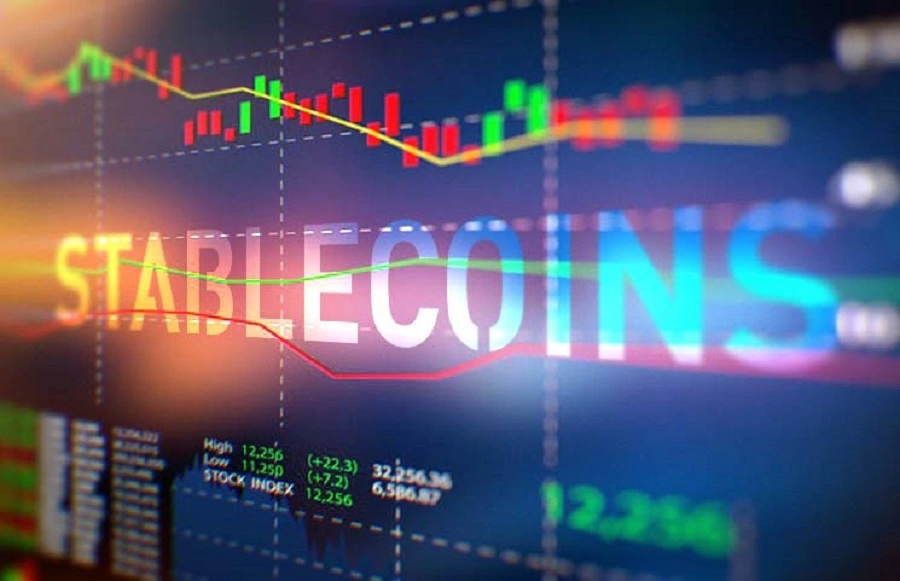A stablecoin is a type of cryptocurrency that is backed by a reserve asset and aims to provide price stability.
Stablecoins have gained popularity since they try to combine the best of both worlds: the rapid processing and security or privacy of cryptocurrency payments, as well as the volatility-free and stable prices of fiat currencies.
- Stablecoins are cryptocurrencies that attempt to peg their market value to some external reference.
- May peg to a currency like the U.S. dollar or to a commodity’s price such as gold.
- They achieve their price stability via collateralization (backing) or through algorithmic mechanisms of buying and selling the reference asset or its derivatives.
Understanding Stablecoins
Though Bitcoin (BTCUSD) remains the most popular cryptocurrency, its prices are notoriously volatile.
Even its intraday price swings can be extreme; it’s not uncommon for the cryptocurrency to move more than 10% in each direction in a few of hours.
![]()
Bitcoin and other prominent cryptocurrencies are unsuitable for everyday use due to their short-term volatility.
A currency should essentially serve as a medium of monetary exchange and a means of storing monetary value, with its value remaining relatively steady over extended time periods. Users will be hesitant to accept it if they are unsure about its purchasing power in the future.
In an ideal world, a crypto coin would preserve its purchasing power while having the lowest possible inflation, which would encourage people to spend their tokens rather than save them. Stablecoins offer a way to accomplish this desirable behavior.
Types of Stablecoins
Fiat currencies (such as the US dollar) have some appeal since they are by the full confidence and credit of the government that issued them. For fiat currencies, this provides some price stability. However, many fiats are inherently under control by their central banks as a result of this. Stablecoins are a type of cryptocurrency that attempts to bridge the gap between fiat and digital currencies. Stablecoins have three groups based on their operating mechanics.
Fiat-Collateralized Stablecoins
Fiat-collateralized stablecoins use a fiat currency reserve, such as the US dollar, to issue a sufficient amount of crypto coins. Other types of collateral include precious metals like as gold and silver. As well as commodities such as oil, however the majority of today’s fiat-collateralized stablecoins employ dollar reserves.
Independent custodians manage such reserves, which audit on a regular basis to ensure that they meet essential compliance.
Tether (USDTUSD) and TrueUSD (TUSDUSD) are popular crypto currencies that are backed by dollar deposits and have the same value as a single US dollar.

Crypto-Collateralized Stablecoins
Stablecoins are crypto-collateralized.
Because the reserve cryptocurrency may be volatile, such stablecoins are over-collateralized, which means that a larger number of cryptocurrency tokens are as a reserve for releasing a smaller number of stablecoins.
For example, $2,000 in ether might retain as reserves for releasing $1,000 in crypto-backed stablecoins. It would account for up to 50% of reserve currency movements (ether).
Price stability improves through more frequent audits and monitoring.
MakerDAO’s DAI (DAIUSD) is backed by Ethereum (ETHUSD) and tied to the US dollar, allowing for the use of a basket of crypto assets as a reserve.
Non-Collateralized (Algorithmic) Stablecoins
Non-collateralized stablecoins don’t have any reserves. However they do have a working mechanism to keep the price stable, similar to that of a central bank.
The dollar-pegged basecoin, for example, employs a consensus method to increase or reduce token production based on demand. Such operations are comparable to a central bank producing banknotes to sustain fiat currency valuations.
It is possible to achieve this by developing a smart contract on a decentralized platform that can execute independently.
Stablecoin Regulation
Given the scale of their $130 billion market and potential impact on the broader financial system, regulators continue to scrutinize stablecoins.
Stablecoins should regulate as financial market infrastructure alongside payment systems and clearinghouses, according to the International Organization of Securities Commissions (IOSCO) in October 2021.
The proposed regulations would target stablecoins that regulators consider to be systemically important and capable of disrupting payment and settlement processes.
Furthermore, legislators have stepped up their calls for more stablecoin monitoring. Senator Cynthia Lummis (R-Wyoming) advocated for regular audits of stablecoin issuers in September 2021. While others support bank-like rules for the sector.
Click here to read more useful and interesting articles.

